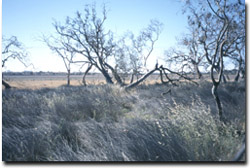Site 3 Lake Cope Cope
Site appears to be in environmental decline and is visibly salt affected
Description
Lake Cope Cope is gazetted as a Public Recreation Purposes Reserve and is circled by a Water Reserve (Stimson 98). The wetland is a Shallow Freshwater Marsh with water supplied from a creek flowing into Lake Grassy then overflowing into Lake Cope Cope from the east.
The site is on an almost level alluvial plain (120 m above sea level) with lunettes to the east. The plain is the result of deposition of sediments from the Richardson River.
The lake is of moderate habitat value due to the high percentage of introduced species and stock grazing. However, the area does have a wide range and age of tree species, fallen timber and is over 200 hectares in size.
| Vegetation Description and Composition The wetland is circled by Open Woodland dominated by Eucalyptus largiflorens (Black Box) and Eucalyptus camaldulensis (Red Gum). The understorey is predominantly Muehlenbeckia florulenta (Tangled Lignum) and Eragrostis infecunda (Cane Grass) and members of the Cyperaceace (Sedge) and Juncaceae (Rush) Families. The two EVCs represented are Plains Grassy Wetland graduating into Plains Grassy Woodland outside the area of the lakebed. The total number of species present has decreased when compared with previous survey results, especially since the 2001 survey. Prolonged dry conditions have caused a large decrease in the number and cover abundance of introduced species, particularly from the Asteraceae Family. |  Looking over Lake Cope Cope from the western edge in spring 2002 |
Three salt indicator plants were present in 1997; eight in 2001 and this has reduced to six in 2002. These results are more likely due to dry seasonal conditions than any sudden favourable change in groundwater salinity. However it does need to be stated that the site is becoming severely salt affected. Salt indicator species present included Critesion marinum (Sea Barley Grass), Lolium rigidum (Wimmera Rye Grass), Atriplex semibaccata (Berry Saltbush), Enchylaena tomentosa (Ruby Saltbush), Sarcocornia spp. (Beaded glasswort) and Wilsonia rotundifolia (Round-leaf Wilsonia).
Tree Health
Eight trees are monitored for tree canopy health using a 20-point system assessing canopy size and density, number of dead branches and extent of epicormic growth. Leaf damage by insects is also assessed. Three trees have experienced decline in health due to reduced canopy density, dead branches and epicormic growth. These are signs of stress due to prolonged dry conditions. Eucalyptus camaldulensis (Red Gum) trees appear to be suffering greater amounts of insect attack and epicormic growth than the Eucalyptus largiflorens (Black Box) trees, because they cannot withstand long periods without inundation. Highly saline groundwater may also be contributing to decline in tree health (refer to groundwater and salinity section).
Water Quality
Lake Cope Cope has remained dry since autumn 1999 and limited water quality data has been collected. Two macroinvertebrate surveys have been performed in spring 1997 and 1998. The first survey found that Lake Cope Cope had medium quality water in terms of organic pollution. Ephemeroptera (Mayflies) and Atyidae (Freshwater Shrimps) taxa that are classed as sensitive to organic pollution were present. They are also sensitive to increases in salinity and would be expected to decline with an increase in levels. In spring 1998 the lake contained a much smaller volume of water, with a subsequent increase in nutrient and salinity concentrations. This was reflected by the absence of the above two taxa along with many other sensitive taxa.
Groundwater and Salinity
Three bores are located around the lake edge. Groundwater levels have varied between one to six metres and display seasonal groundwater behaviour, which corresponds well with lake levels. Apart from the obvious cyclic temporal variation, there are no long term groundwater trends at this stage. Salinity levels are extremely high, two bores recorded just under 20 000 EC and the other 41 500 EC in spring 2002. This is of concern if groundwater levels were to rise when wet conditions return in the future. These high salinity readings are contributing to the declining health of Eucalyptus camaldulensis (Red Gum) trees around the lake.
Birds
Bird species present at the time of the vegetation and tree health surveys were :-
Galah, Magpie, Red-rumped Parrot, Sparrow, Welcome Swallow, White-plumed Honeyeater (hundreds), Willie Wagtail, Masked Lapwing, Pigeon and Eastern Rosella.
Threats to the site continue to be:
- grazing by stock, kangaroos, rabbits and hares
- increased salinity from groundwater intrusion
- weed invasion
- possible future change to flooding regime
- continued tree health decline
- build up of wind blown lakebed sediments on western side of lake


